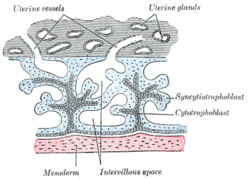Chorionic gonadotropin
| placenta - synciotiotrophoblast | |
| glycoprotein of 237 AMK | |
| corpus luteum | |
| LHCG receptors | |
| 118850 |
Human chorionic gonadotropin (hCG) belongs together with lutropin (LH), follitropin (FSH) and thyrotropin (TSH) to the group of glycoprotein hormones. Unlike other glycoprotein hormones produced in the adenohypophysis, hCG is produced by the syncytiotrophoblast of the placenta during pregnancy. It stimulates the growth of the corpus luteum, which produces estrogens and progesterone.
Chemically, hCG consists of two subunits – 'alpha and beta. The alpha-subunits of all glycoproteins are identical, the biological specificity of these hormones is determined by the beta-subunits.
The presence of hCG in a woman's blood or urine is evidence of pregnancy and helps monitor its progress. A value lower than the normal limit of hCG is a signal for an ectopic pregnancy, a dead fetus or an imminent miscarriage. On the contrary, elevated hCG values signal a multiple pregnancy and enable an early diagnosis of trisomy 21 - Down's syndrome (together with the determination of AFP and uE3). The production of hCG increases rapidly in early pregnancy. We record maximum growth between the 80s and 90s. day of pregnancy, then its production decreases (in the 4th month), and after the 25th week the hCG value remains stable until delivery. Its urinary excretion ends about the 7th day after birth, i.e. after the expulsion of the fetus and placenta.
HCG levels since the beginning of pregnancy and its development[edit | edit source]
| Time since conception | Time since last period | mIU/l[1] |
|---|---|---|
| 7 days | 21 days | 0-5 |
| 14 days | 28 days | 3–426 |
| 21 days | 35 days | 18–7 340 |
| 28 days | 42 days | 1,080–56,500 |
| 35-42 days | 49-56 days | 7,650-229,000 |
| 43-64 days | 57-78 days | 25,700-288,000 |
| 57-78 days | 79-100 days | 13,300-253,000 |
| 17-24 week | Second trimester | 4,060–65,400 |
| From week 25 | Third trimester | 3,640–117,000 |
Links[edit | edit source]
Related Articles[edit | edit source]
References[edit | edit source]
- KLENER, Paul. Internal Medicine. 3rd revised and supplemented edition edition. Galen, 2006. ISBN 80-7262-430-X.
- KOBILKOVÁ, Jitka. Fundamentals of Gynecology and Obstetrics. 1. edition. Galen, 2005. 368 pp. ISBN 80-7262-315-X.
References[edit | edit source]
- ↑ NASEPORODNICE.CZ,. Level of hCG in the blood - hormone signaling the beginning of pregnancy [online]. [cit. 2011-02-09]. <http://www.naseporodnice.cz/hladina-hcg-v-krvi-hormon-signalizujici-pocatek-tehotenstvi.php>.


